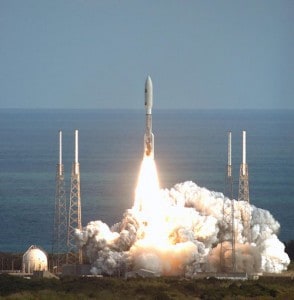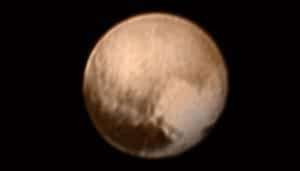
Do you remember where you were on January 19, 2006? On that date, at 1:00 p.m. Central Standard time, (CST) the Atlas 5 rockets shot the New Horizons spacecraft towards space! The probe left earth at about 36,250 miles per hour – the fastest ever for a NASA mission. In a post-launch interview, the principal investigator for New Horizons, Alan Stern, said, “The United States has a spacecraft on its way to Pluto, the Kuiper Belt and on to the stars.” He continued, “I have July 14, 2015 emblazoned on my calendar.”
Tomorrow, July 14, 2015, at 6:49 a.m. CST, New Horizons will fly within 7,800 miles of Pluto’s surface. It will be passing Pluto at 30,800 miles per hour and it will only take about 8 minutes to fly past. Cameras aboard the spacecraft with have resolved features on Pluto’s surface as small as the ponds of Central Park. Shortly after New Horizons passes Pluto, NASA scientists will receive the final picture that was taken of Pluto before the fly-by. It takes nearly 4.5 hours to transmit signals sent between Earth and New Horizons. Photos from New Horizons will be delayed because during the fly-by all of its resources will be oriented towards Pluto. On the day of the fly-by only engineering data will come down. On the 15th the science data will begin again. The earliest photos of Pluto are scheduled to be released around 2 p.m. CST on Wednesday, the 15th. It will take nearly 16 months for all of the photos and scientific data to be transmitted to Earth.
Pluto has been the subject of some controversy over the last few years. In 2006, the International Astronomical Union (IAU) reclassified Pluto as a dwarf planet rather than a planet. The IAU redefined the definition of “planet,” and Pluto no longer fits the criteria. Some feel this is a “demotion” for Pluto. Dave Jewitt, however, believes it can be considered a promotion since our perception has been transformed. And, in The 50 most extreme places in our solar system David Baker and Todd Radtcliff note that Pluto is not a planet, but is now a dwarf planet, a Kuiper Belt object (one of the largest), a Trans-Neptunian Object (TNO), and a plutoid (a classification for dwarf planets that are also TNOs).
And, no, Pluto was not named after the Disney character. On March 13, 1930, the discovery of the ninth planet was officially announced and suggestions for names came from all over the world. The winning name came from a young schoolgirl, Venetia Burney, from Oxford, England. She thought that because the planet was so far away from the Sun, in its own dark realm, it should be named after the Roman god of the underworld – Pluto.
Riding aboard the NASA spacecraft are ashes of the late astronomer Clyde Tombaugh, who discovered the planet in 1930 at the Lowell Observatory in Flagstaff, Arizona. Tombaugh died January 17, 1997, nine years to the day of New Horizons first launch attempt. The launch was delayed twice due to weather.

On December 6, 2014 at 8:53 p.m. (CST), New Horizons came out of a nearly 9-year hibernation. In the nearly 3 billion mile trip, New Horizons spent 2/3 of its life in 18 separate hibernation periods. The hibernation periods lasted from 36 to 202 days and helped preserve fuel and the spacecraft’s components. The on-board flight computer did not hibernate and would send a weekly “beacon-status tone” to let NASA know it was still on its way.
The New Horizons engineers programmed a “wake-up” sequence for December 6, 2014 at 2 p.m. CST. Once that happened, the spacecraft sent a signal to NASA indicating that the power was up and running. New Horizons was more than 2.9 billion miles from earth and the signal took 4 hours and 26 minutes to reach the Deep Space Station in Australia.
Pluto has the most elongated path of any planet and it resembles a comet more than a planet. It is a very slow moving planet and it travels a tremendous distance, therefore, a single orbit of Pluto around the sun lasts at least 248 years.

Since New Horizons won’t go into Pluto’s orbit, it will keep going – heading beyond Pluto to visit more objects within the Kuiper Belt. Information from these encounters will be similar to that received about Pluto – helping us learn about the composition and atmospheres of these rocks. Stern notes that this Wednesday, July 15th, 2015, is the 50th anniversary of the day Mariner 4 flew by Mars. New Horizons will collect 5,000 times as much data as that mission did.
Go outside tomorrow at 6:49, look to the heavens and think of the historic trip of New Horizons – 9 1/2 years across 3 billion miles of space.
RESOURCES:
Reaching for Pluto: NASA launches probe to Solar System’s edge. January 19, 2006. Space.com
Coming in 2015: the first spacecraft encounter with Pluto. December 8, 2014. Popular Science.

Weintraub, David A. 2007. Is Pluto a planet? a historical journey through the solar system. Princeton, N.J. : Princeton University.
Baker, David. 2010. The 50 most extreme places in our solar system. London, England ; Cambridge Mass. Belknap Press of Harvard University.
Bond, Peter. 2007. Distant Worlds : milestones in planetary exploration. New York : Copernicus, in association with Praxis Plublishing, Ltd.
New Horizons spies Charon orbiting Pluto. August 7, 2014. NASA
Why New Horizons’ closest approach to Pluto will be just 8 minutes long. July 13, 2015. Los Angeles Times : Science Now.
Other Resources:
Kuiper Belt. July 13, 2015. Wikipedia.org.
Tyson, Neil deGrasse. 2009. The Pluto files : the rise and fall of America’s favorite planet. New York : W.W. Norton.
Elkins-Tanton, Linda T. 2011. Uranus, Neptune, Pluto, and the outer solar system. New York : Facts on File.
Jones, Barrie William. 2010. Pluto : sentinel of the outer solar system. New York : Cambridge University Press.